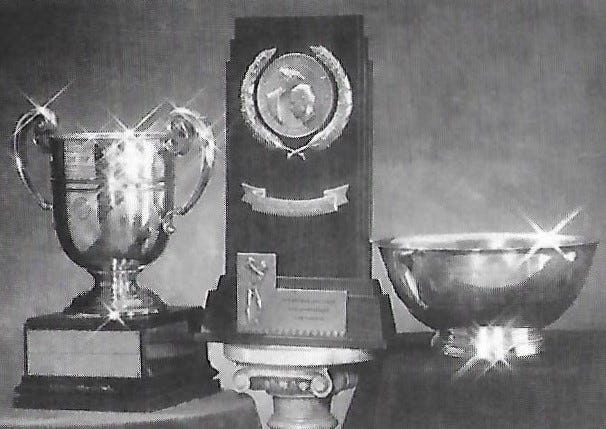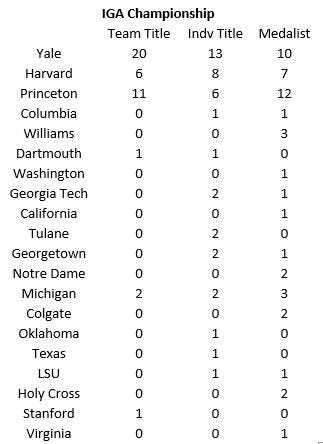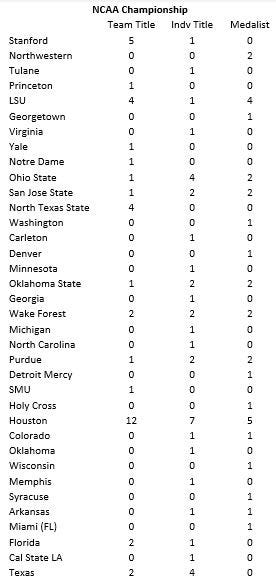This is part of a series on the Men’s Collegiate Championships
NCAA Championship Era: 1939-NOW
Intercollegiate Championship #78: June 25-28, 1975
Host: Ohio State University Scarlet Course
The Ohio State University course has been a regular host of the NCAA golf championships, taking up the honor for the 6th time in 1975. Each of the previous 5 times they have hosted saw a legendary coach lead their team to victory: Eddie Twiggs [Stanford] in 1941, Ohio State’s own Robert Kepler in 1945, Fred Cobb [North Texas (State)] in 1951, and Dave Williams [Houston] in 1956 and 1970. Defending champion Wake Forest, coached by Jesse Haddock, had finished 2nd in 1970 and looked primed to add to that historic list in 1975.
Format
Team and Individual stroke play
Day 1 = 18 holes
Day 2 = 18 holes
**Cut to top 15 teams as well as those within 18 strokes
**Cut to individuals within 10 strokes of the individual leader as well as those on teams which made the cut
Day 3 = 18 holes
Day 4 = 18 holes
**72 holes determines Team and Individual championships
Results
Team Champ: Wake Forest (2 NCAA, 2 overall)
Prior to finally breaking through in 1974, Wake Forest had a number of close calls in the NCAA championship: finishing 3rd in 1968, runner-up to Houston in both the 1969 and 1970 championships, 4th in 1971, and T6 in 1972. The 1973 championship had been a tough one, failing to make the 16 team cut. Everything changed in dramatic fashion on the final hole in the final round of the 1974 championship when freshman Curtis Strange stuck his 1-iron second shot on the par 5 to 7 feet where he had two putts to win the team championship for Wake Forest over defending champ Florida and tie the individual championship with Florida’s Gary Koch and Phil Hancock. Instead, Strange buried the eagle putt and took both titles. The 1974-75 Wake Forest team with sophomore Curtis Strange and junior Jay Haas ran through the regular season in such a dominant fashion that a Golf World article written by Ryan Herrington in 2001 would dub them the best college golf team ever. Leading up to the 1975 championship, the defending NCAA champs accumulated 7 tournament titles including their 9th straight ACC championship - which they won by 36 shots - and Strange defending his ACC individual title. Everyone was ready for another Florida-Wake Forest showdown at the NCAAs, but instead it was Oklahoma State which was only three strokes behind Wake Forest after two rounds. They widened that gap slightly to 6 strokes entering the final round, but history had proven that no lead was safe. There were no dramatic comebacks on this day, however, as Wake Forest’s 4 eventual counting scores put on a clinic touring the course in 284 strokes (4-under-par), giving them a tournament total of 1156 (+4). The next closest competitor in the final round was actually USC whose counting scores posted a 304 (+16), finishing T3 overall along with Alabama. Oklahoma State retained 2nd place for the tournament, but their final round counting score total of 307 (+19) gave them a final total of 1189 (+37). When the final putt fell, Wake Forest had not only successfully defending their team championship, they had set an NCAA record with their historic 33-stroke victory! Even after considering many of the historically great teams that have come since the 2001 article - the 2003 Clemson, 2013 California, 2014 Alabama, and 2018 Oklahoma State teams are contenders - this 1975 Wake Forest team still stands the test of time as one of if not THE greatest men’s college golf team ever.
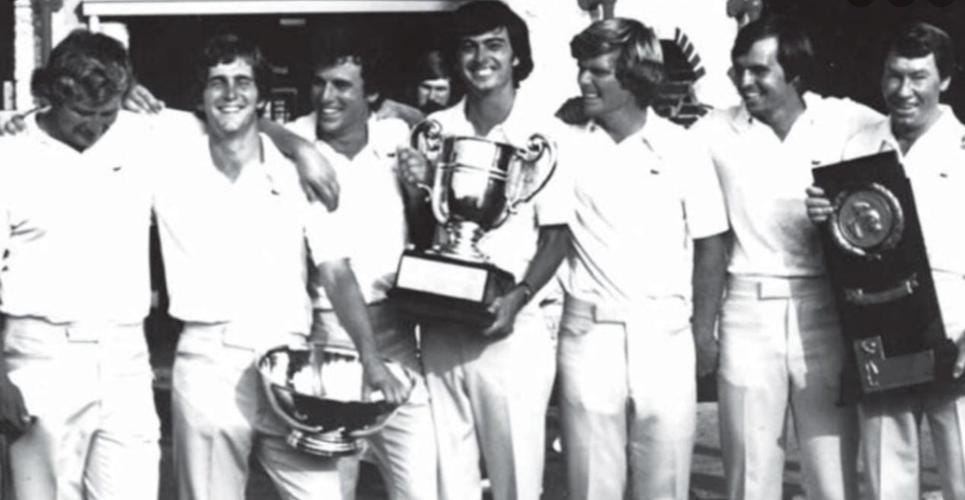

Individual Medalist/Champ: Jay Haas [Wake Forest]
As mentioned above, the freshman campaign for Curtis Strange was already the stuff of legend, making him a easy favorite for the 1975 championship. The college golf world had just seen Ben Crenshaw [Texas] three-peat in his first three championships, so Strange repeating, however unlikely, was not out of the realm of possibility. After finishing with identical 71-72=143 scores in the first two rounds, Strange and teammate Jay Haas sat T2 just two strokes back of Ohio State's Craig Carson, playing on his home course. The two Deacons separated ways in the next round, though, when Haas went under par with a 69 while Strange went over par with a 74. Through three rounds, Haas (212) held a narrow 1-stroke lead over Carson, Tom Jones [Oklahoma State], and Jerry Pate [Alabama] - the defending US Amateur champion who shared low amateur honors with Haas at this year’s US Open1. Not one to give in to pressure, Strange bounced back in a big way with a final round (and tournament) low score of 67 to post a four-under-par 284. Despite his incredible play, Strange had dug himself too deep of a hole to catch Haas and Pate who were neck and neck coming down the stretch. Although Pate caught and even briefly passed Haas a couple of times through the round, the latter regained the lead for good on the par five 14th hole with a two-putt birdie to Pate's par. With the team title firmly in hand, the individual battle was the dominating storyline as the final pairing made their way to the 18th (72nd) green where both had long birdie putts. Pate, down one stroke, went first and left his ball just inches short. Haas had two strokes to claim the championship but left himself with a 3-foot tester. As the ball slammed home with authority, Haas gave an animated fist pump amidst the roar of the large crowd surrounding the green. Once again both the Maxwell Cup (team championship) and Chick Evans Bowl (individual championship) were returning to Wake Forest to the surprise of few and delight of Coach Haddock.
Championship Award Count
EXTRA HOLES: 5-Count-4 DAILY
After the 1975 Wake Forest team set an NCAA record with their 33-stroke victory, there was apparently a number of discussions on potential format changes including moving from an aggregate 5-count-4 format - where the 4 counting scores are determined at the end of the tournament - to a daily version where the drop score was determined at the end of each round. The thinking was that this would help teams who weren’t as deep or else count good scores in the event players got sick or injured. Whether this was something already in the works or a new proposal seems a little hazy, but a couple of sources including the above mentioned article from Golf World suggest that the change, which was eventually instituted in 1978 and continues across every college golf tournament to this day, unambiguously suggest the historic Wake Forest win was the primary instigator. So what would have happened if the 1975 championship had been scored using the daily 5-count-4? A mere 27 stroke victory of 1152 (4 strokes lower) to Oklahoma State’s 1179 (10 strokes lower).
Sometime in the near future we intend to do an extensive write-up examining the various format changes since the post-WWI move to decide the team championship by #-count-4 stroke play and see how retroactively applying this daily 5-count-4 format might have changed things. Should be fun!
COACHES CORNER: Jesse Haddock [Wake Forest]
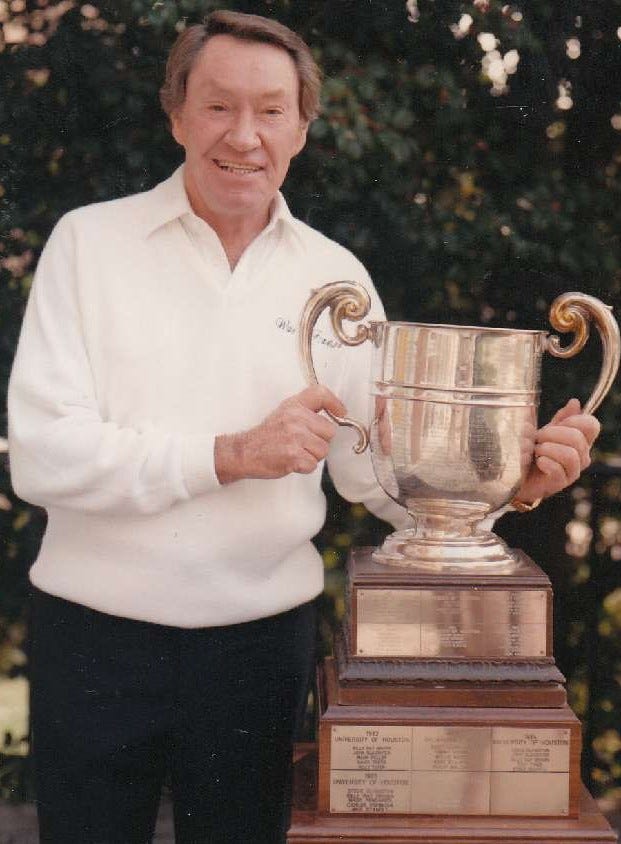
Like other coaches of his era, Jesse Haddock was not exactly a golfer, having not picked up the game until 1959, a couple years before he would take up the head coaching mantle from Horace “Bones” McKinney. But what Coach Haddock lacked in knowledge about the swing he more than made up for in both organization and discipline, applying his business degree from Wake Forest (1952) to lead his alma mater’s golf team to success that few else would achieve. Over a 32 year career that lasted into the early 1990s, Coach Haddock set the tone that teamwork and accountability were some of the most important factors for success, getting players to buy into “the process” long before that was a common sports trope. In this incredibly insightful article from 2009, former walk-on Bill Stines (‘84) had this to say: “Coach Haddock made us work hard…knowing that there was no substitute for effective daily practices. He especially like to put us in pressure situations to see if we could handle it. He understood golf, psychology, motivation and good communications and used his knowledge wisely. He was ahead of his time in understanding the mental side of the game, and he pushed players to accomplishments they may never have been able to obtain otherwise.” Clearly what he did worked as 63 Deacon golfers earned All-American status during his tenure.
Following the magical back-to-back championships in 1974-75, Wake Forest was able to finish a more than respectable 4th behind a solo-7th last hurrah for Curtis Strange. The next decade was a series of ups and downs for Coach Haddock’s teams, with top 10 finishes in 1977 and 1978, finishing 3rd behind Ohio St and Oklahoma State in 1979, missing the cut in 1980, top 10 finishes in 1980 and 1981, then hanging right around the 15-team cut mark in 1982-85. Wake Forest again (1979) hosted the championship at the Bermuda Run Country Club in 1986, this time getting the better of Oklahoma State by 4 shots. The third NCAA championship put Coach Haddock in rarified air with only 4 other coaches to reach that mark: Eddie Twiggs [Stanford], Fred Cobb [North Texas], Dave Williams [Houston], and Mike Holder [Oklahoma State]. The 1987 team proved the win was no fluke, finishing 2nd to Oklahoma State at Ohio State’s Scarlet Course. Two years before his retirement, the 1991 team added one more top 5 finish to Coach Haddock’s legacy with a solo-4th finish at Pebble Beach’s Poppy Hills course.
Coach Haddock passed away in March, 2018 at the age of 91. He lived long enough to see the construction of a $4.5 million dollar state-of-the-art golf facility bearing his name added to the Arnold Palmer Golf Complex on the Wake Forest University campus, serving as a fitting home for the many accolades and golf memorabilia earned over the course of his Hall of Fame career.
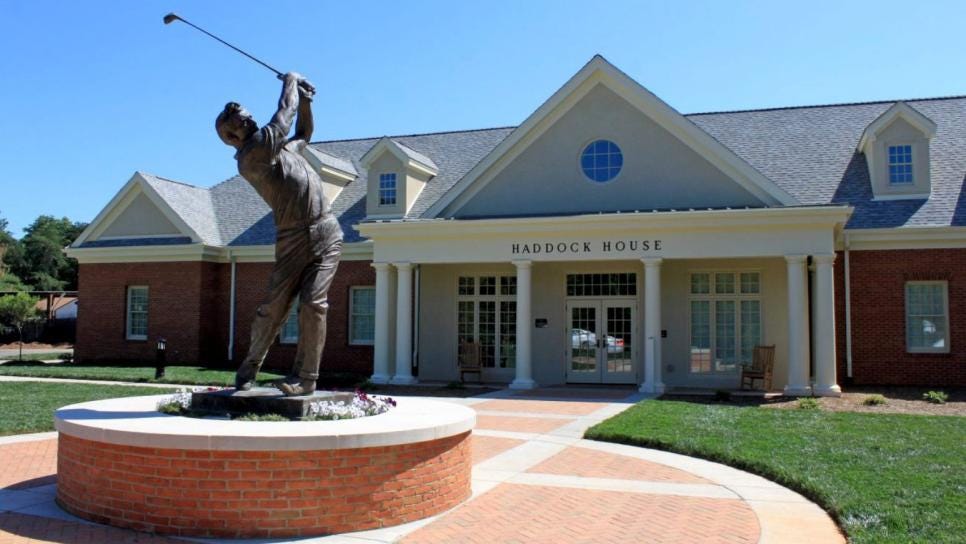
Thanks for reading!
Up Next:
In the next post we will cover the 1989 championship which signified the start of two important eras: the Phil Mickelson domination and the use of Regionals to determine entry into the Championship.
Alabama’s Jerry Pate would go on to win the 1976 US Open in his rookie year on the PGA Tour.




